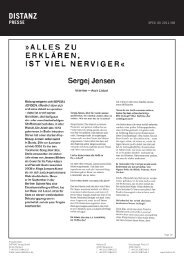ZEICHNUNGEN VON MONICA BONVICINI, 1986 ... - DISTANZ Verlag
ZEICHNUNGEN VON MONICA BONVICINI, 1986 ... - DISTANZ Verlag
ZEICHNUNGEN VON MONICA BONVICINI, 1986 ... - DISTANZ Verlag
Erfolgreiche ePaper selbst erstellen
Machen Sie aus Ihren PDF Publikationen ein blätterbares Flipbook mit unserer einzigartigen Google optimierten e-Paper Software.
alex Müller<br />
cassioPeia unD Der alberich<br />
„Es muss auch das Nichterklärliche Bestandteil unserer Gesellschaft sein …“ Alex Müller<br />
“The inexplicable, too, must be an element of our society …” Alex Müller<br />
alex Müller (geb. 1971 in Düren, lebt<br />
und arbeitet in Berlin) beschäftigt<br />
sich mit Malerei und skulptur und<br />
inszeniert Räume als begehbare Bilder.<br />
Die arbeiten überführen organische<br />
Materialien wie Äpfel oder Blaumohn<br />
und Gegenstände, die der alltagsrealität<br />
entnommen sind, in fantastische,<br />
paradoxe und rätselhafte anordnungen.<br />
neben autobiografischen Quellen spielt<br />
das kulturelle Gedächtnis einer medial<br />
geprägten Gesellschaft eine zentrale<br />
Rolle bei der Findung dieser Konstellationen.<br />
Die inspiration durch Fernsehserien<br />
aus der Kindheit und Jugend,<br />
die Bewunderung für Filme macher wie<br />
Peter Greenaway und die Faszination<br />
für mythologisches und astrologisches<br />
Wissen sind von großer Bedeutung.<br />
Dementsprechend changieren die Werke<br />
zwischen identifikation und Geheimnis,<br />
sinnstiftung und Hermetik. Mit einem<br />
text von Patrizia Dander und einem<br />
Vorwort von Renate Goldmann.<br />
alex Müller (b. Düren, 1971; lives<br />
and works in Berlin) devotes herself<br />
to painting and sculpture and stages<br />
rooms as walk-in pictures. Her works<br />
transpose organic materials such as<br />
apples or opium poppy and objects<br />
taken from everyday reality into<br />
fantastic, paradoxical, and enigmatic<br />
arrangements. in addition to autobiographical<br />
sources, the cultural memory<br />
of a society defined by media plays a<br />
central role as the artist devises these<br />
constellations. inspiration drawn from<br />
the television shows of her childhood<br />
and youth, her admiration for filmmakers<br />
such as Peter Greenaway, and<br />
her fascination with mythological<br />
and astrological knowledge are of<br />
crucial importance in this process. Her<br />
works accordingly oscillate between<br />
identification and secrecy, between the<br />
creation of meaning and hermeticism.<br />
includes an essay by Patrizia Dander<br />
and a preface by Renate Goldmann.<br />
Cassiopeia, 2011<br />
alles da, 2011, und/and Der kluge Apfel, 2011, installationsansicht/installation view, Leopold-Hoesch-Museum Düren 2011 Lying in Redorange, 2008<br />
Sleeping Figure in Red, 1997/2010<br />
neW<br />
Ed. Leopold-Hoesch-Museum<br />
& Papiermuseum Düren<br />
Renate Goldmann<br />
German / English<br />
24 × 30 cm<br />
72 pages, approx. 60 color and b/w<br />
images, hardcover<br />
isBn 978-3-942405-71-3<br />
£ 22.99 / $ 40.00<br />
€ 24.90 (D)<br />
leiko ikeMura<br />
transFiguration – FroM Figure to lanDscaPe<br />
Mensch und Natur, Zeit und Raum verschmelzen miteinander<br />
A Fusion of Man and Nature, of Time and Space<br />
Das über dreißigjährige Werk von Leiko<br />
ikemura (geb. 1951 in Mie, Japan, lebt<br />
und arbeitet in Berlin und Köln) besteht<br />
aus Gemälden, aquarellen, zeichnungen<br />
sowie terrakotta- und Bronzeskulpturen.<br />
in den 1980er Jahren widmete<br />
sich die Künstlerin der Malerei, die in<br />
dieser Frühphase über die intensität der<br />
Farbe und den expressiven Duktus eine<br />
starke Emotionalität transportiert. seit<br />
den frühen 1990er Jahren tauchen Mädchenfiguren<br />
als zentrales thema in ihren<br />
Bildern und als Plastiken auf. Leiko<br />
ikemura versteht sich als Grenzgängerin<br />
zwischen japanischer und abendländischer<br />
Kunst. Die okzidentalen Einflüsse<br />
finden sich auch im Kopfmotiv, einem<br />
zweiten Hauptthema ihres schaffens.<br />
in den 2007 begonnenen großformatigen<br />
Landschaften findet eine auseinandersetzung<br />
mit japanischer Kunst in Form<br />
von stilisierten Bergen, Flüssen und<br />
Wolken statt.<br />
Mit einem text von Julian Heynen.<br />
Over more than thirty years, Leiko<br />
ikemura (b. Mie, Japan, 1951; lives and<br />
works in Berlin and Cologne) has built<br />
an oeuvre that encompasses paintings,<br />
watercolors, drawings, and terracotta<br />
and bronze sculptures. in the 1980s,<br />
the artist devoted herself to painting;<br />
in this early phase of her oeuvre, intense<br />
colors and expressive brushwork convey<br />
a sense of strong emotions. since the<br />
early 1990s, figures of girls appear as a<br />
central theme in her pictures and sculptures.<br />
Leiko ikemura sees herself as<br />
an interloper between the arts of Japan<br />
and the Western world. Occidental<br />
influences are also evident in the motif<br />
of the head, a second central theme of<br />
her art. the large-format landscapes she<br />
began work on in 2007 engage Japanese<br />
art in the forms of stylized mountains,<br />
rivers, and clouds.<br />
With an essay by Julian Heynen.<br />
Leiko ikemura<br />
TransfiguraTion<br />
from figure<br />
To Landscape<br />
German / English<br />
22,5 × 28 cm<br />
160 pages, approx. 120 color images<br />
hardcover<br />
isBn 978-3-942405-69-0<br />
Release: October 2012<br />
£ 37.50 / $ 60.00<br />
€ 39.90 (D)<br />
40 41<br />
neW



